Group leader: 22070830 Zeng Junbo
Team members: 22070806 Dai Jie 22070818 Shi Yanwei 22070827 Tian Renhe 22070829 Gu Bao
Abstract
In the broad field of astronomy, the study of stars has always been a key part of exploring the mysteries of the universe. As a special type a star, Am star has become a research hotspot because of its unique spectral characteristics. These metallic wire stars not only show distinctive characteristics in spectrum, but also provide valuable clues for understanding the chemical composition, physical process and evolution path of stars. This paper aims to provide a comprehensive and detailed guide on how to identify Am stars, from basic theory to practical operation steps, so as to ensure that readers can systematically master this complex process. By combining advanced spectral analysis technology and rigorous scientific methods, we hope to provide a clear path for astronomy lovers and professional researchers to explore and identify these mysterious stars. This paper will elaborate on the definition and spectral characteristics of Am star, and how to use MKCLASS code and other tools to effectively classify and identify the spectrum, and finally realize the accurate discrimination of Am star. This paper shows how to improve the efficiency and accuracy of recognition through the combination of automation and expert system.
1. Introduction
Star classification is a basic research field in astronomy, in which Am star has attracted much attention because of its unique spectral characteristics. Am stars belong to a special branch of type a stars. The abundance of metal elements in its atmosphere is abnormal, which leads to its spectrum is significantly different from that of ordinary type a stars. These differences provide important clues for studying the internal structure, physical process and evolution path of stars, and are of great significance for understanding the chemical evolution of the galaxy.
With the continuous progress of observation technology, especially the use of large astronomical facilities such as the large sky area multi-target optical fiber spectrum telescope (LAMOST), astronomers have obtained a large amount of star spectral data. These data provide an unprecedented opportunity for the systematic study of Am star. However, the accurate identification of AM stars from massive data requires the combination of advanced spectral analysis technology and rigorous scientific methods. This article will introduce in detail how to use MKCLASS code and other tools to systematically identify Am star from theory to practice. By describing each step in detail, this paper aims to enable readers not only to understand the recognition process of Am star, but also to operate and reproduce the research results.
In particular, this paper will focus on the important role of spectral recognition platform in the recognition of AM stars. The spectrum recognition platform not only provides the function of automatic processing and analysis, but also combines the wisdom of expert system to make complex spectrum analysis efficient and accurate. Through this platform, researchers can quickly screen candidates for Am star, conduct detailed manual inspection, and finally confirm the identity of Am star. This process not only improves the recognition efficiency, but also ensures the reliability of the results.
2. Article analysis
2.1 basic definition of Am star
Am stars, fully known as am type chemical pecuriar stars, or metal wire stars, belong to a special branch of type a stars. They show unique characteristics in the spectrum, which are derived from the high abundance of metal elements in the atmosphere. Compared with ordinary A-type stars, the CA II K-line of AM stars is weaker, showing a decrease in calcium (CA) and scandium (SC), and an increase in iron peak elements and rare earth elements. The distribution of these characteristic elements is a significant sign of Am star.
2.2 spectral characteristics of AM stars
2.2.1 spectral classification:
The spectral classification of AM stars is complex, and their types are mainly distributed in the range of F0 to A4. This means that they are located at the colder end of type a stars and close to type F stars on the hertzsprung Russell diagram.
Different classification methods, such as metal line, hydrogen Balmer line and calcium CA II K line, may lead to different spectral types. The specific relationship can be expressed as: SP type (K line)<SP type (H line)<SP type (metallic line).
It should be noted that:
Based on metal wire (SP (m)): due to the enhancement of metal wire, the spectral type is given later.
Based on the hydrogen Balmer line (SP (H)): it is closely related to the effective temperature of stars, and can better estimate the effective temperature (teff).
Based on CA II K-line (SP (k)): due to the weak CA II K-line, the spectral type is given earlier.
2.2.2 characteristic spectral lines:
CA II K line: the CA II K line of Am star is relatively weak, which is due to the low abundance of calcium in its atmosphere. This feature is particularly obvious in spectral analysis and is one of the important basis for identifying Am stars.
Balmer line: the Balmer line of Am star (such as h, h, etc.) is relatively significant, which is closely related to the effective temperature of the star. The effective temperature (teff) of stars can be estimated by analyzing Balmer line.
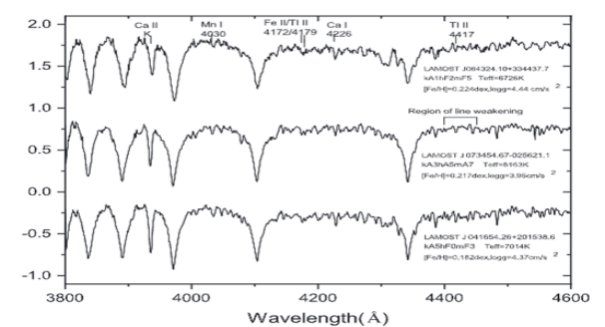 Fig. 1 spectral line characteristics of Am star
Fig. 1 spectral line characteristics of Am star
3. Identification method and specific operation
3.1 method introduction: spectral classification based on MKCLASS code
MKCLASS is a program for stellar spectral classification, which is applicable to a variety of operating systems, including UNIX and Linux. The program needs to input star spectral data in a specific format, and relies on a spectral standard library to perform classification. MKCLASS can only handle the spectrum from purple light to green light at present, and it is expected to expand its function in future versions. The user can operate MKCLASS through the command line, including the path of spectral file, the spectral library used, the path of output file, the path of log file, the selection of classification method and the number of iterations. The program output includes spectral type and quality evaluation, and the log file records the classification process in detail. MKCLASS also provides tools for preprocessing spectra, including extracting data from fits files, truncating to a specific wavelength range, and adjusting the resolution through Gaussian smoothing to match the resolution of the standard library. In addition, users can create their own spectral library to extend the functions of MKCLASS.
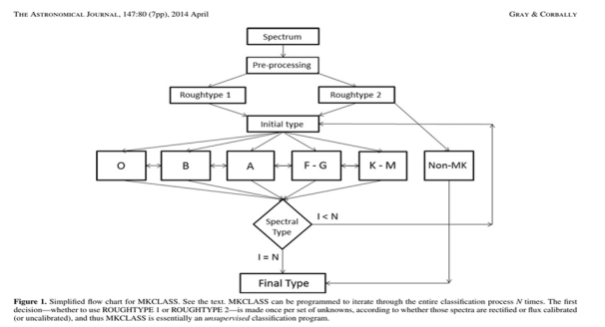 Figure 2 Schematic diagram of MKCLASS program
Figure 2 Schematic diagram of MKCLASS program
3.2 specific operation steps
3.2.1 data source and preprocessing
1. data source:
Our data comes from the low resolution spectral data of the large sky multi-target Optical Fiber Spectral Telescope (LAMOST). LAMOST provides a large number of star spectral data, which covers a wide range of star types, including Am star. LAMOST's data release 8 (v1.0), 9 (V0) and 10 (V0) provide us with a wealth of samples, enabling us to systematically study Am stars.
In addition to LAMOST data, we also refer to other astronomical databases, such as SDSS (Sloan Digital Sky Survey) and Gaia, to obtain more observation data and background information. The combination of these data provides us with a more comprehensive perspective and helps to improve the accuracy and reliability of identification.
2. data preprocessing:
Download data: download the latest data through FileZilla client. For example, we downloaded more than 600000 spectral data from September 18, 2023 to June 3, 2024. These data are stored on the LAMOST data server and can be easily downloaded to the local directory through the FileZilla client.
Decompress data: decompress the downloaded data using Python programs to ensure data integrity and availability. The extracted data usually contains multiple fits files, and each file contains a star spectrum.
Format conversion: converts fits files to CSV comma separated files for subsequent analysis. This step ensures the consistency of data format and facilitates MKCLASS program processing.
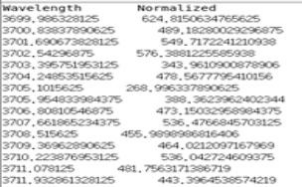 Figure 3 fits file format conversion
Figure 3 fits file format conversion
3.2.2 spectral screening and identification
automatic filtering:
Input data: input the preprocessed spectral data into MKCLASS code. We released 8 (v1.0), 9 (V0) and 10 (V0) low resolution spectra using LAMOST data, and detected about 21600 am type star candidates.
Parameter setting: set the parameters of MKCLASS in the command line, including spectral file path, used spectral library, output file path, log file path, classification method selection and iteration times. For example:
Output results: MKCLASS output includes spectral type and quality evaluation, and the classification process is recorded in detail in the log file. These results provide a basis for subsequent cross matching and manual inspection.
manual inspection:
Import platform: import the obtained candidate Am stars into the expert spectrum recognition platform for comparison of characteristic spectral lines. The expert spectrum recognition platform is a system integrating a variety of analysis tools and expert knowledge, which can provide detailed spectral analysis and comparison functions.
Comparison standard: compare the abundance of common metal lines such as K line, H line and Fe line. Specific standards are as follows:
CA II K line: weak, indicating low calcium abundance.
H-line: relatively significant, closely related to the effective temperature of stars.
Fe line: obviously enhanced, indicating high iron abundance.
4.Practical application of the method
4.1. reproduction of the identification process of article achievements
According to the recognition method of Am star by teacher tianxiaoman's team, our team reproduced the key step, i.e. MKCLASS identification and screening of Am star. At the same time, we manually identified and screened again, and compared the results with the code results to verify the correctness of the method, realizing the imitation and reproduction of previous results.
 Figure 4 MKCLASS recognition results
Figure 4 MKCLASS recognition results
The recognition results are stored in the text file at the same time, and the text file is successfully compared with the predecessors through the python program, which successfully realizes the reproduction of the results, the matching degree is perfect, and the process of drawing ladles according to the gourd is successfully realized.
4.2 processing and results of the latest data
4.2.1 data download
The latest data of DR12 was obtained through FileZilla client. The team used all the spectral data of more than 600000 pieces from September 18, 2023 to June 3, 2024.
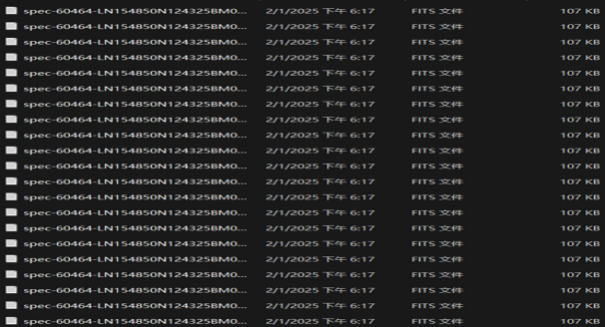 Figure 5
Figure 5
4.2.2 data preprocessing
The latest data is decompressed by Python program, and the conversion from fits file to CSV comma separated file is realized to obtain the available spectral file to be analyzed.
4.2.3 screening of the latest data
Use the web program mentioned in 3 to process the new DR12 spectral data (Figure 6)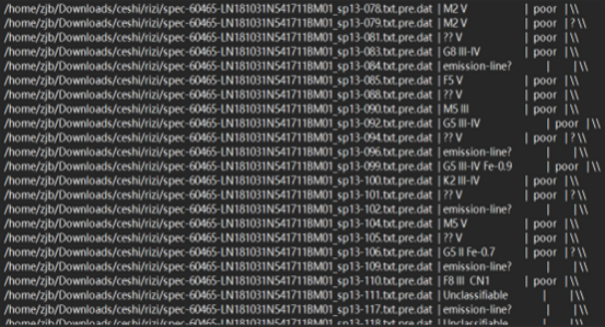 Figure 6
Figure 6
Through the combination of Python and manual screening, the qualified am satellite candidate targets are obtained, and the candidate targets are manually identified and determined.
4.2.4 manual inspection
The obtained candidate Am stars are imported into the expert spectrum recognition platform to manually compare the characteristic spectral lines and compare the abundance of common metal lines such as K line, H line and Fe line.
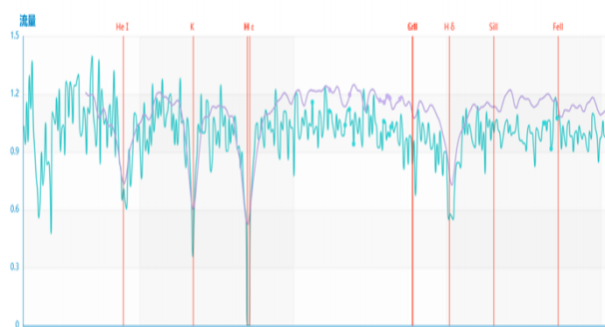 Figure 7 Am star template matching
Figure 7 Am star template matching
It can be seen that the abundances of H line and K line are obviously weakened, while the metal lines such as SR line and Fe line are obviously enhanced. It can be seen that the judgment is correct, and the sample is indeed an Am star.
5.Advantages and limitations of the method
5.1MKCLASS
5.1.1 professionalism in processing spectra in a specific wavelength range
MKCLASS currently focuses on processing the spectrum from purple light to green light. This wavelength range covers many important characteristic regions in the stellar spectrum, such as hydrogen line (H line), calcium line (K line), etc. These feature lines play a key role in star classification. By carefully analyzing the spectrum within this specific wavelength range, MKCLASS can capture the subtle features of stars, so as to achieve more accurate classification. Moreover, focusing on a specific wavelength range also makes the program more efficient in processing data, can concentrate resources on the analysis of key information, and improves the classification efficiency.
5.1.2. convenience of data format conversion
MKCLASS provides a series of preprocessing tools such as extracting data from fits files, truncating to a specific wavelength range, and adjusting the resolution through Gaussian smoothing to match the resolution of the standard library. In practical applications, stellar spectral data is often stored in fits format, and MKCLASS can easily convert fits files into CSV comma separated files. This format conversion ensures the consistency of data format and facilitates MKCLASS program processing. For example, with the extract fits to \uu CSV function in the python program, users can easily extract and convert the spectral data in fits files into CSV format to prepare for subsequent spectral classification. Moreover, the operation of these preprocessing tools is relatively simple. Users can quickly start data preprocessing without having a deep programming foundation, which improves work efficiency.
5.1.3. accuracy of resolution adjustment
The function of adjusting the resolution through Gaussian smoothing to match the resolution of the standard library is one of the highlights of the MKCLASS preprocessing tool. The resolution of stellar spectral data from different sources may be different, but the spectral data in the standard library usually have the same resolution. This function of MKCLASS can ensure that the input spectral data is consistent with the spectrum in the standard library in resolution, thus ensuring the accuracy of comparison in the classification process. For example, when the input spectral data has a high resolution, it can be reduced to the resolution matching the standard library through Gaussian smoothing, which avoids the classification deviation caused by inconsistent resolution and improves the reliability of classification results.
5.2 important role of spectral recognition platform
The SpecZoo plays an important role in the process of Am star recognition.
Data processing and visual spectral image: the platform automatically processes the downloaded fits file to obtain the corresponding visual spectral image.
Feature comparison: the platform integrates various spectral templates and spectral line data, and can automatically compare the characteristic spectral lines, such as CA II K line, H line and Fe line, and quickly and accurately display the spectral template of Am star, that is, the characteristic spectral line.
Detailed analysis: the platform provides detailed spectral analysis tools, and users can manually adjust the analysis parameters, such as apparent velocity and redshift value, for more in-depth spectral analysis. This helps to find the details that may be missed in the automatic processing, and improves the accuracy of identification.
6. Conclusion
It is estimated that there will be more than 1500 new Am stars after the latest more than 600000 lamostdr12 samples are identified by program and manually inspected
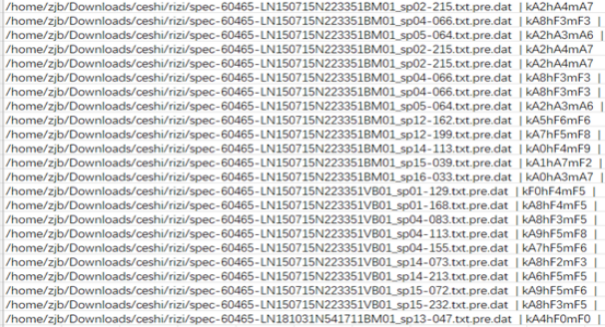 Figure 8 predicted partial Am stars
Figure 8 predicted partial Am stars
7.Future outlook
In the future, our team will continue to screen the old unprocessed spectral data and the newly released spectral data to label the new Am star. We will strive to improve the accuracy and efficiency of screening and labeling, and actively explore new technologies and methods to further improve our research level and ability to ensure that more Am stars can be accurately and efficiently identified and labeled. We will also actively cooperate with research teams in other related fields to jointly promote the development of Am star research.
References
[1] 田晓曼, et al. (2023). A New Catalog of Am-type Chemically Peculiar Stars Based on LAMOST. The Astrophysical Journal Supplement Series.
[2] Kurucz, R. L. (1993). ATLAS9: Model Atmospheres and Spectra. In IAU Symposium 154, Stellar Atmospheres: Beyond Classical Models (pp. 225-232). Kluwer Academic Publishers.
[3] Soubiran, C., et al. (2016). The Gaia-ESO Survey: Chemical abundances of 1500 FGK stars from the UVES spectra. Astronomy Astrophysics, 595, A109.
[4] Tian X, Wang Z, Zhu L, et al. A New Catalog of Am-type Chemically Peculiar Stars Based on LAMOST[J]. The Astrophysical Journal Supplement Series, 2023, 266(1): 14.
[5] Conti P S. The Metallic-Line Stars[J]. Publications of the Astronomical Society of the Pacific, 1970, 82(488): 781-808.
[6] Roman N G, Morgan W W, Eggen O J. The Classification of the Metallic-Line Stars[J]. Astrophysical Journal, vol. 107, p. 107-109, 1948, 107: 107-109.
[7] Gray R O, Corbally C J. An expert computer program for classifying stars on the MK spectral classification system[J]. The Astronomical Journal, 2014, 147(4): 80
[8] Titus J, Morgan W W. On the Classification of the a Stars. I. The Spectral Types of the Brighter Members of the Hyades Cluster[J]. Astrophysical Journal, vol. 92, p. 256, 1940, 92: 256.
[9] Abt H A. The Frequency of Binaries among Metalmc-Line Stars[J]. Astrophysical Journal Supplement, vol. 6, p. 37, 1961, 6: 37.
appendix
1. filter and website Python code:
2. bash script code for spectral file preprocessing:
3.dockerfile bash script code:
4. convert CSV file Python code: